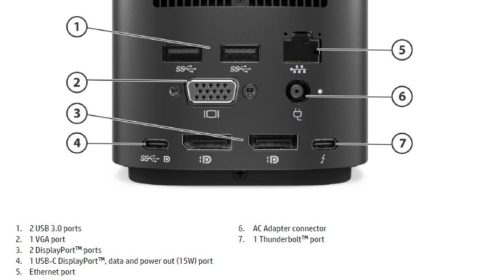
HP Thunderbolt Dock G2: Dual-monitor-support with MacBookPro?
Update: January, 15th, 2024
I use the HP Thunderbolt Dock G2 (120W) from HP professionally with my HP Probook 440 G7. I asked myself if I could also use this docking station to run my personal Intel® MacBookPro 13″ 2019 on the two 1080p monitors. After all, the Thunderbolt 3 interface should make that possible. But the dock’s specs deny Apple Macintosh compatibility. This field report describes whether it works after all.
The HP dock works without issue with 2 full-HD (1920×1080) monitors with my HP Probook 440 G7, no matter which port combination I use:
- 2 x DisplayPort (3) or
- 1 x DisplayPort (3) and 1 x VGA (2) as expected.
- 1 x DisplayPort and 1 x USB-C (4), even via a USB-C-to-HDMI/DisplayPort adapter. Thunderbolt 3 (7) does not work.
I can use the clone or the extended mode. Two 4K-displays @60 Hz should also work according to the specifications if they are connected to the DisplayPorts (3) or USB-C-DP (4).
With my Intel MacBookPro 2019, it’s a different story. If a monitor is connected to VGA (2), it is not recognized by macOS, but the monitor on DisplayPort (3) is.
If both monitors are connected to the two DisplayPorts (3) of the docking station, the MacBook recognizes both displays. Unfortunately, both monitors can only be used in clone mode and not in extended mode. The same happens when one of the two monitors is connected to the DisplayPort-compatible USB-C port (4).
Extended 2-Monitor Operation
Update: According to the tip from Anurag Kothari from March 2023 in the comments, extended dual-monitor operation works if you use two DisplayPort monitors. Unfortunately, I was only able to verify this till now.
To do this, connect any DisplayPort of the docking station (1) to a DisplayPort monitor using a normal DisplayPort cable. Connect the Thunderbolt 3 port of the docking station (7) to another DisplayPort monitor with a USD-C-to-DisplayPort cable. A USB-C-to-HDMI cable in connection with an HDMI monitor does not work.

Extended 2-Monitor-Operation
It may be necessary to disconnect and reconnect or restart the MacBookPro so that all monitors are detected.
Workaround: With a USB-C-to-HDMI or DisplayPort adapter which is connected to a free Thunderbolt 3 port of the MacBookPro, it is possible to use dual-monitor mode. The other monitor has to be connected to the DisplayPort (3) of the dock.
This should work up to 4K displays @60Hz. The internal display works in extended mode, too. The MacBookPro is charged via the Thunderbolt 3 interface. All other connections work, too.
Conclusion
Is the HP Thunderbolt Dock G2 compatible with a 2019 Intel MacBookPro? Partially. Almost complete. Is the dock dual-monitor-compatible? No. Does a workaround exist? Yes, if you use the appropriate cables and monitors.
As long as you only have one monitor connected to one of the DisplayPorts or only want to use the 2-display clone mode, it is compatible with the MacBookPro. Dual-monitor operation in extended mode is not possible. The VGA port makes also problems in dual-mode.
However, with the workaround mentioned above, it is possible to establish dual-monitor operation. You just need to connect 2 cables to the MacBookPro instead of one.
What works with the MacBookPro?
- Charging via Thunderbolt 3 cable (no Apple power adapter needed)
- USB ports (incl. keyboards, mice, etc.)
- Ethernet port
- Both DisplayPorts (3) in clone mode, only
- Dual monitor operation in clone-mode (up to 4K @60Hz)
- Dual monitor operation in extended-mode (up to 4K @60Hz)
What doesn’t work?
- VGA port
- Both DisplayPorts (3) in extended mode
Dual monitor operation in extended mode (except workaround, see above)
So this HP dock came close in regards to MacBookPro compatibility. I cannot say if you can transfer these experiences to other Thunderbolt-3-MacBooks as mine or not, especially the M1/2/3 ones.
However, readers have reported in the comments that the following models work for them:
- MacBook Pro M1 Pro (Bob Smith)
- MacBook Air M2 (Mark)
- MacBook Pro M3 Pro (Ulf)
Thank you for your contribution.

If your monitor has display ports then you can connect the 2nd Monitor to the ThunderBolt Port (Port 7 in your Diagram Above) using a usb-c to display port cable and it should work. I have it working with my MacBook Pro running Ventura 13.2.1.
Ref: https://h30434.www3.hp.com/t5/Notebook-Hardware-and-Upgrade-Questions/HP-Thunderbolt-Dock-G2-to-Mac-book-pro/m-p/6802690/highlight/true#M472386
Thanks & Regards
-Anurag
Thank you Anurag! This fixed my issue with an M1pro! So easy!! 🙂
Thank you, Anurag, for your input. Unfortunately, I was only able to verify your suggestion today and have updated my blog post. Thank you very much.
Will this also work with an MacBook Air M2?
Thank you for your contribution.
works with Macbook pro M3 Pro! Thank you!!!
Thank you, Ulf.
Hi everyone.
I am struggling with the above mentioned guidelines, and maybe you can help me out.
My Hardware:
MBP M3 Pro 14 inch.
2x MAG274QRFDE-QD
HP TB 4 Dock
DP Cabels
HDMI Cables
USB C Cables
USB to DP Cable
I have tried every configuration possible with those and there is either just one screen on or 2 with the same image.
What I found out is that the TB Port on my Dock seems not usable as a display output. There is a DP alt port with USB C connector and that works – but it behaves like a regular DP port and just gives me one image. No configuration (that works on the USB-C DP Port) works if I plug any cable into the TB port.
I also have tried it with my HP Essential Dock G5 – there is no TB and there are no 2 displays recognized also.
I could try to look for a Monitor FW Update. That is what I haven’t updated maybe. But everything else is up to date.
What would you suggest to do next?
Hi Flo,
I do not know if the G4 works with your MBP-M3-Pro. But both have TB 4.
Anyway, according to Apple the MBP M3 PRO should support two external screens up to 6K, the MBP M3 (w/o PRO) does not. But you wrote you own a M3 PRO, right? Ulf wrote he got his MBP M3 Pro running with the G2 dock.
First try out if you MBP can handle two screens directly w/o the dock. Connect one screen to MBP’s HDMI with a decent HDMI-Kabel (use a up-to-date one!) and the other to one of the MBP’s TB4s with a USB-C-to-DP cable.
If this does not show the desired result the cables are probably the problem. You have to fix this first. Use different ones or …
As I read in the specifications, your screens also have a USB-C port. As a second approach, try a connection with a pure USB-C cable from the TB of the MBP to the USB-C of the display. For one or both screens. However, make sure that the USB-C cable is display-compatible. Not all of them are.
I you get this running, you can try to make the dock working. Connect the HDMI cable to the HDMI port of the dock (#8, refer image in [1]) and to a monitor. Connet a USB-C-to-DP or the diplay.-compatible USB-C cable to the lower right TB port (#9).
Good luck.
Hani
[1] https://www.hp.com/us-en/monitors-accessories/computer-accessories/thunderbolt-G4-dock.html
Thank you for the effort and input!
The direct connection works.
Either through the dock via DP #4 / 7 or HDMI #8 or USB-C #6 + an additional directly connected cable USB-C to USB-C or DP from the MBP. The same is true for the HDMI port of the Mac..
Best Regards
Flo
Hmm, I had exactly the same problem at first. It only worked when I connnected …
… similar to your approach. That was my workaround in the first version of this blog-post.
Until Anurag commented on replacing the USB-C-to-HDMI cable with a UPS-C-to-DP cable and connecting the G2 #7 (G4 #9) to it. Have you tried #9? Have you asked the HP service? Anyway.
I think I might at least have found the answer…
It is called display link and no longer supported by my TB G4 Dock. G2 seems to still support that.
BR
Flo